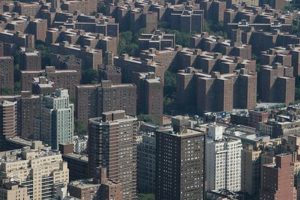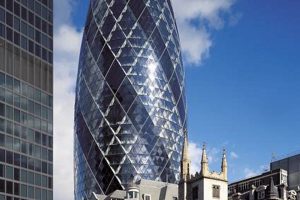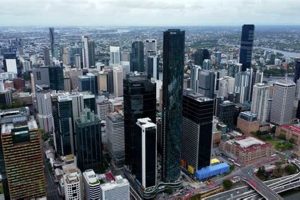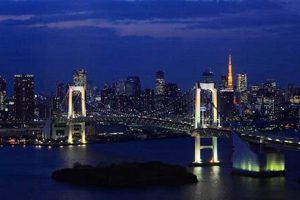A skyscraper, also known as a “high-rise” or “tower,” is a continuously habitable building that has over 40 floors and is at least 150 meters (492 feet) in height, based on the Council on Tall Buildings and Urban Habitat’s definition.
Skyscrapers play a crucial role in urban planning and development. They enable the efficient use of land space, accommodating a large number of people and businesses in a centralized location. Skyscrapers also contribute to the economic prosperity of cities by attracting investments, fostering innovation, and creating employment opportunities.
Historically, the construction of skyscrapers has been driven by advancements in engineering, architecture, and technology. Notable examples include the Empire State Building in New York City, the Petronas Towers in Kuala Lumpur, and the Burj Khalifa in Dubai, which currently holds the record as the tallest building in the world.
1. Height: Reaching towards the heavens, skyscrapers soar above their surroundings, often becoming iconic landmarks.
The height of a skyscraper is a defining characteristic that contributes significantly to its iconic status. By soaring above their surroundings, skyscrapers create a powerful visual impact that can reshape the skyline of a city. This vertical dominance not only sets them apart from other buildings but also transforms them into landmarks that are easily recognizable and often associated with the identity of the city.
The height of a skyscraper is not merely an aesthetic consideration; it is also a testament to engineering prowess and architectural innovation. Constructing a building that reaches hundreds of meters into the sky requires careful planning, advanced materials, and cutting-edge construction techniques. The ability to build taller and taller skyscrapers pushes the boundaries of human ingenuity and serves as a symbol of a city’s ambition and progress.
The iconic status of skyscrapers is further enhanced by their unique ability to offer breathtaking views from their upper floors. Observation decks and rooftop terraces provide visitors with panoramic vistas that stretch for miles, allowing them to experience the city from a whole new perspective. These elevated vantage points not only add to the overall appeal of skyscrapers but also create memorable experiences for tourists and residents alike.
In conclusion, the height of a skyscraper is a crucial factor that contributes to its iconic status. By reaching towards the heavens, skyscrapers become landmarks that define the skyline, showcase architectural innovation, and offer unparalleled views. Their height is not just a measure of their physical presence but also a reflection of the ambition, creativity, and engineering prowess of the cities they grace.
2. Design
The design of a skyscraper is not just about aesthetics; it is also about pushing the boundaries of engineering and innovation. Skyscrapers are often designed to be as tall and slender as possible, which requires careful planning and the use of advanced materials and construction techniques. The result is often a building that is both beautiful and awe-inspiring.
One of the most important aspects of skyscraper design is the structural system. The structural system is responsible for transferring the weight of the building to the ground. In order to achieve the desired height and slenderness, skyscrapers often use innovative structural systems, such as diagrid structures and outrigger systems.
Another important aspect of skyscraper design is the facade. The facade is the exterior skin of the building, and it plays a major role in the overall appearance of the building. Skyscrapers often use innovative facade designs to create a distinctive and memorable look. For example, the Burj Khalifa in Dubai uses a glass facade that is designed to reflect the desert sun.
The design of a skyscraper is a complex and challenging process, but it is also a rewarding one. When done well, a skyscraper can be a work of art that is both beautiful and functional.
3. Function
Skyscrapers are not just architectural marvels; they are also functional buildings that serve a variety of purposes. The most common uses for skyscrapers are commercial and residential, but they can also be used for other purposes, such as hotels, hospitals, and educational institutions.
- Commercial Skyscrapers
Commercial skyscrapers are used for a variety of business purposes, including offices, retail stores, and restaurants. They are often located in central business districts and are designed to accommodate a large number of people. Some of the most famous commercial skyscrapers in the world include the Empire State Building in New York City and the Petronas Towers in Kuala Lumpur.
- Residential Skyscrapers
Residential skyscrapers are used for housing. They are often located in densely populated urban areas and are designed to provide a comfortable living environment for residents. Some of the most famous residential skyscrapers in the world include the Burj Khalifa in Dubai and the One World Trade Center in New York City.
- Mixed-Use Skyscrapers
Mixed-use skyscrapers are buildings that combine commercial and residential uses. They are becoming increasingly popular as they offer a convenient and efficient way to live and work in the same building. Some of the most famous mixed-use skyscrapers in the world include the Shanghai Tower in China and the Marina Bay Sands in Singapore.
Skyscrapers are a vital part of the modern urban landscape. They provide a variety of functions and services that are essential to the functioning of a city. As cities continue to grow, skyscrapers will continue to play an important role in meeting the needs of their residents and businesses.
4. Sustainability
Modern skyscrapers are increasingly incorporating eco-friendly features to reduce their environmental impact. This is in response to the growing awareness of the need to protect the environment, as well as the increasing demand for sustainable buildings from tenants and investors.
There are a number of ways that skyscrapers can be made more sustainable. These include:
- Using energy-efficient lighting and appliances
- Installing solar panels to generate renewable energy
- Using green building materials
- Recycling rainwater
- Reducing waste
By incorporating these features, skyscrapers can reduce their greenhouse gas emissions, water consumption, and waste production. This not only benefits the environment, but it can also save money for building owners and tenants.
Here are som
e examples of sustainable skyscrapers:
- The Burj Khalifa in Dubai is the tallest building in the world, and it is also one of the most sustainable. The building uses a variety of eco-friendly features, including solar panels, recycled materials, and a rainwater collection system.
- The One World Trade Center in New York City is another example of a sustainable skyscraper. The building is LEED-certified, and it uses a variety of eco-friendly features, including a green roof, solar panels, and a rainwater collection system.
- The Shanghai Tower in China is the second tallest building in the world, and it is also one of the most sustainable. The building uses a variety of eco-friendly features, including wind turbines, solar panels, and a rainwater collection system.
These are just a few examples of the many sustainable skyscrapers that are being built around the world. As the demand for sustainable buildings continues to grow, we can expect to see even more innovative and eco-friendly skyscrapers in the future.
5. Urban Planning
Skyscrapers, with their towering heights and condensed footprints, play a pivotal role in the meticulous orchestration of urban landscapes. By optimizing land usage and enabling efficient transportation networks, skyscrapers contribute significantly to the livability and sustainability of cities.
- Vertical Expansion: Optimizing Land Use
In densely populated urban environments, skyscrapers provide a creative solution to the scarcity of horizontal space. By extending development upwards, cities can accommodate more people and businesses within a limited geographical area. This vertical expansion not only preserves valuable land for other essential uses, such as parks and green spaces, but also reduces urban sprawl, curbing the encroachment of cities into surrounding natural ecosystems.
- Transportation Hubs: Facilitating Efficient Movement
Skyscrapers often serve as central hubs for transportation networks, seamlessly integrating various modes of transport. Many skyscrapers are strategically located near public transportation stations, making it convenient for occupants to access buses, trains, and subways. Additionally, some skyscrapers feature dedicated helipads and underground connections to facilitate rapid movement of people and goods. By promoting connectivity and reducing reliance on personal vehicles, skyscrapers contribute to decongesting roads and improving overall traffic flow within urban areas.
- Mixed-Use Developments: Fostering Vibrant Communities
Modern skyscrapers often incorporate mixed-use developments, housing a diverse range of functions within a single structure. This approach creates vibrant and self-sustaining micro-communities, where residents and workers can live, work, shop, and socialize without the need for extensive travel. Mixed-use skyscrapers promote walkability, reduce commuting times, and foster a sense of community engagement.
- Sustainable Design: Enhancing Urban Resilience
Skyscrapers are increasingly designed with sustainability principles in mind, incorporating green building technologies and renewable energy sources. This focus on environmental stewardship contributes to the long-term sustainability of cities, reducing carbon emissions, conserving water, and improving air quality. Sustainable skyscrapers promote healthier living environments for occupants and contribute to the overall resilience of urban ecosystems.
In conclusion, skyscrapers are not merely architectural marvels but also essential components of well-planned urban environments. Their ability to optimize land use, facilitate efficient transportation, foster vibrant communities, and promote sustainability makes them indispensable tools for shaping livable, sustainable, and thriving cities.
6. Economic Impact
Skyscrapers, with their towering heights and impressive architectural designs, are not just symbols of urban development but also significant contributors to the economic vitality of cities. They serve as economic hubs that attract businesses, investments, and foster job creation, playing a crucial role in driving urban growth and prosperity.
- Vertical Business Centers
Skyscrapers provide ample space for businesses to establish their operations, offering modern and efficient work environments that cater to diverse industries. The concentration of businesses in skyscrapers creates a synergistic environment, facilitating collaboration, networking, and knowledge sharing. This vertical clustering of economic activity attracts companies seeking proximity to clients, partners, and specialized services, fostering a vibrant business ecosystem.
- Investment Magnets
Skyscrapers, with their iconic status and architectural prowess, often become landmarks that attract investors seeking prestigious and high-profile addresses for their ventures. The presence of skyscrapers indicates a city’s economic stability and growth potential, making them prime targets for domestic and international investments. These investments not only contribute to the construction and maintenance of skyscrapers but also stimulate the development of surrounding infrastructure and amenities, generating a ripple effect that benefits the entire urban economy.
- Job Creation Engines
The construction, maintenance, and operation of skyscrapers create numerous employment opportunities. From architects and engineers to construction workers and property managers, a wide range of professionals are involved in the skyscraper industry. Additionally, the businesses housed within skyscrapers generate jobs in various sectors, including finance, technology, law, and consulting. Skyscrapers act as catalysts for job creation, contributing to the economic well-being of individuals and families.
- Tourism and Hospitality Boosters
Iconic skyscrapers often become major tourist attractions, drawing visitors from around the world. Observation decks, rooftop restaurants, and luxury hotels located in skyscrapers offer unique experiences and panoramic views of the city. This tourism influx generates revenue for businesses and supports the hospitality industry, creating jobs and stimulating economic growth in the surrounding areas.
In conclusion, skyscrapers are not just architectural marvels but also powerful economic drivers. Their ability to attract businesses, investments, and foster job creation makes them vital contributors to the economic prosperity of cities. By providing vertical business centers, attracting investments, generating employment opportunities, and boosting tourism, skyscrapers play a pivotal role in shaping the economic landscape of urban environments.
7. Cultural Significance
Skyscrapers, with their towering heights and impressive architectural designs, transcend their functional purpose and often become deeply embedded in the cultural fabric of the cities they inhabit. They serve as symbols of urban identity, representing the aspirations, achievements, and ambiti
ons of the communities they reside in.
The cultural significance of skyscrapers stems from their ability to embody the spirit and values of a city. For instance, the Empire State Building in New York City has become an iconic symbol of American resilience and determination, particularly after the tragic events of 9/11. Similarly, the Petronas Towers in Kuala Lumpur represent Malaysia’s rapid economic development and its emergence as a major player on the global stage.
Beyond their symbolic value, skyscrapers also contribute to the cultural landscape of cities by providing unique experiences and shaping urban lifestyles. Observation decks, rooftop restaurants, and luxury hotels located in skyscrapers offer breathtaking views and exclusive amenities, attracting tourists and locals alike. These venues become destinations in their own right, adding to the city’s cultural offerings and contributing to its overall vibrancy.
Moreover, skyscrapers serve as backdrops for cultural events, artistic expressions, and community gatherings. The facades of skyscrapers often become canvases for light displays, projections, and public art installations, transforming the urban environment into a dynamic and interactive space. These artistic interventions not only enhance the aesthetic appeal of skyscrapers but also foster a sense of community pride and engagement.
In conclusion, the cultural significance of skyscrapers lies in their ability to represent the aspirations and achievements of cities, shape urban identities, and contribute to the cultural landscape. By embodying the spirit of innovation, ambition, and progress, skyscrapers become iconic landmarks that are deeply intertwined with the cultural fabric of the cities they grace.
Skyscraper FAQs
This section addresses frequently asked questions and misconceptions about skyscrapers, providing concise and informative answers.
Question 1: What is the defining characteristic of a skyscraper?
Skyscrapers are distinguished by their exceptional height, typically exceeding 40 floors and reaching a minimum height of 150 meters (492 feet), as defined by the Council on Tall Buildings and Urban Habitat.
Question 2: What are the primary functions of skyscrapers?
Skyscrapers primarily serve commercial and residential purposes, housing offices, retail stores, apartments, and other facilities within their vertical structures.
Question 3: Why do cities build skyscrapers?
Skyscrapers offer several advantages in urban environments. They optimize land use, accommodate large populations and businesses in centralized locations, and contribute to economic growth by attracting investments and fostering job creation.
Question 4: Are skyscrapers environmentally sustainable?
Modern skyscrapers increasingly incorporate sustainable design features such as energy-efficient lighting, solar panels, recycled materials, rainwater collection systems, and other green technologies to minimize their environmental impact.
Question 5: How do skyscrapers impact urban transportation?
Skyscrapers are often integrated with public transportation hubs, offering convenient access to subways, buses, and other modes of transport, reducing traffic congestion and promoting walkability.
Question 6: What are some iconic examples of skyscrapers?
Notable skyscrapers include the Empire State Building in New York City, the Petronas Towers in Kuala Lumpur, the Burj Khalifa in Dubai, and the Shanghai Tower in China, each showcasing unique architectural designs and engineering feats.
In summary, skyscrapers are towering structures that serve diverse urban functions, contribute to economic growth, and embody architectural innovation. Their sustainable design features and integration with transportation networks make them valuable assets in modern cities.
Now, let’s delve into a more detailed exploration of skyscrapers and their significance in urban development.
Skyscraper Tips
Skyscrapers, with their towering heights and architectural marvels, present unique opportunities and challenges in design and functionality. Here are some valuable tips to maximize the potential of these iconic structures:
Tip 1: Prioritize Structural Integrity
The foundation and structural framework of a skyscraper are paramount to its stability and safety. Employ robust engineering principles, advanced materials, and innovative techniques to ensure the building can withstand various forces, including wind, earthquakes, and potential impacts.
Tip 2: Optimize Space Utilization
Maximize the vertical space available by implementing efficient floor plans and utilizing multi-purpose areas. Consider vertical gardens, sky lobbies, and rooftop terraces to create functional and visually appealing spaces that enhance occupant well-being.
Tip 3: Integrate Sustainable Features
Incorporate sustainable design elements to reduce the environmental impact of skyscrapers. Utilize energy-efficient systems, renewable energy sources, rainwater harvesting, and green building materials to create eco-friendly and cost-effective structures.
Tip 4: Enhance Accessibility and Inclusivity
Ensure accessibility for all users by providing ramps, elevators, and other assistive technologies. Design inclusive spaces that cater to individuals with disabilities, including accessible restrooms, workspaces, and public areas.
Tip 5: Foster Community and Connectivity
Create communal spaces and amenities within the skyscraper to encourage interaction and a sense of community among occupants. Incorporate shared lounges, fitness centers, and rooftop terraces to promote social connections and foster a lively atmosphere.
Tip 6: Leverage Technological Advancements
Embrace technological advancements to enhance the functionality and efficiency of skyscrapers. Implement smart building systems for energy management, security, and occupant comfort. Utilize high-speed internet and communication systems to facilitate seamless connectivity.
Tip 7: Consider Aesthetic Appeal
While functionality is crucial, do not overlook the aesthetic appeal of the skyscraper. Collaborate with architects and designers to create a visually striking structure that complements the surrounding cityscape and becomes a landmark in its own right.
Tip 8: Ensure Long-Term Maintenance and Upkeep
Plan for the long-term maintenance and upkeep of the skyscraper to ensure its durability and safety. Establish a comprehensive maintenance program that addresses structural integrity, mechanical systems, and aesthetic upkeep to preserve the building’s value and functionality for years to come.
By incorporating these tips, architects, engineers, and urban planners can create skyscrapers that not only meet functional requirements but also enhance the urban landscape, promote sustainability, and foster a thriving community.
Skyscrapers
Skyscrapers, with their towering heights and architectural marvels, have transformed the skylines of cities worldwide. They are not merely symbols of urban development but also play crucial roles in economic growth, sustainability, and cultural identity. This exploration of skyscrapers has highlighted their multifaceted nature and the key aspects that define their significance.
As we look towards the future, skyscrapers will continue to evolve, embracing new technologies and sustainable practices. They will serve as testaments to human ingenuity and ambition, shaping the urban landscapes of tomorrow. By optimizing design, functionality, and community engagement, skyscrapers can become beacons of progress and prosperity, contributing to the vitality and well
-being of cities.







